|
The
|
THE BURGENLAND BUNCH NEWS - No. 327 January 31, 2022, © 2022 by The Burgenland Bunch All rights reserved. Permission to copy excerpts granted if credit is provided. Editor: Thomas Steichen (email: tj.steichen@comcast.net) BB Home Page: the-burgenland-bunch.org BB Newsletter Archives: BB Newsletters BB Facebook Page: TheBurgenlandBunchOFFICIAL Our 26th year! The Burgenland Bunch Newsletter is issued monthly online. The BB was founded in 1997 by Gerald Berghold, who died in August 2008. |
| Current Status Of The BB: * Members: 3106 * Surname Entries: 9058 * Query Board Entries: 5880 * Staff Members: 13 |
This newsletter concerns: 1) THE PRESIDENT'S CORNER 2) BURGENLÄNDERS IN CHICAGO (by Tim Hermesdorf) 3) STUBITS REUNION—THROUGH WILLIAM IGNATIUS STUBITS (1932-2021) (by Helen Stubits Yeager) 4) HISTORICAL BB NEWSLETTER ARTICLES: - THE CHOSEN (by Della Cummings Wright) 5) ETHNIC EVENTS 6) BURGENLAND EMIGRANT OBITUARIES (courtesy of Bob Strauch) |
1) THE PRESIDENT'S CORNER (by Tom Steichen)  My
Covid note for the US comes from the New York Times "state of the virus" update for January 14th, which
indicated that the Omicron variant had pushed US daily case reports to record levels, with more than 800,000
new infections reported each day and with widespread case growth across the country. Hardest hit areas then were Alaska,
Oregon and Utah, with new infections up about 400 percent over prior weeks. However, infections seem to have peaked in some
of the first-hit places such as Puerto Rico, Cleveland, Chicago, New York City and Washington, DC. About 150,000 coronavirus
patients were hospitalized nationwide then (more than at any previous point in the pandemic) and about 1,900 deaths were
occurring each day, a 50 percent increase over prior weeks. We can wish this thing were over... but sadly it is not. My
Covid note for the US comes from the New York Times "state of the virus" update for January 14th, which
indicated that the Omicron variant had pushed US daily case reports to record levels, with more than 800,000
new infections reported each day and with widespread case growth across the country. Hardest hit areas then were Alaska,
Oregon and Utah, with new infections up about 400 percent over prior weeks. However, infections seem to have peaked in some
of the first-hit places such as Puerto Rico, Cleveland, Chicago, New York City and Washington, DC. About 150,000 coronavirus
patients were hospitalized nationwide then (more than at any previous point in the pandemic) and about 1,900 deaths were
occurring each day, a 50 percent increase over prior weeks. We can wish this thing were over... but sadly it is not.However, the potential light-at-the-end-of-the-tunnel is that Omicron may be moving us from pandemic to endemic. A disease that is endemic has a constant presence but does not affect an alarmingly large number of people or disrupt society, as typically seen in a pandemic. Omicron, with its high infection rate but lower deadliness, may be the means to immunize most people against Covid-19. "There are four other corona viruses that have become endemic," according to David Heymann, a professor of infectious disease epidemiology at the London School of Hygiene and Tropical Medicine. The natural history of infections indicates that Covid-19 will be the fifth, he added. If so, it will become just another annual cold or flu that will affect only a small number of people each year. So there is hope! This month's random bits and pieces (Article 1) begins with a little railroading in Oberwart, announces the availability of marriage and death record transcriptions for the Catholic parish of Sankt Martin an der Raab, comments on the recent activities of former Burgenland Governor, Hans Niessl, talks about skeletons found in St. Margarethen, provides a What’s New on GenTeam report, skates around some ice on Lake Neusiedl, and ends with news about a new social housing initiative in Burgenland. Our regular tidbits kick off with the monthly update on corona-virus happenings in Burgenland and continue with the monthly BB Facebook report, book sales, a recipe and a cartoon-of-the-month. In Article 2, BB member Tim Hermesdorf takes a look at where Burgenländers settled in Chicago, making it the largest Burgenländer city in the world in the early 20th century. While the "Little Burgenland" neighborhood on the southside was well-known, Tim also delineates a northside Burgenland neighborhood that was equally as large. Article 3 comes to us via BB member Werner Stubits of Perchtoldsdorf, Austria. However, the article, Stubits Reunion—through William Ignatius Stubits (1932-2021), was written by his American relative, Helen Stubits Yeager, and tells the story of how her father reconnected his American family to their Burgenland relatives. The remaining articles are our standard sections: A Historical BB Newsletter article, Ethnic Events and Emigrant Obituaries. Oberwart-Friedberg (Styria) Freight Traffic To Be Expanded: Burgenland had been in discussion with ÖBB 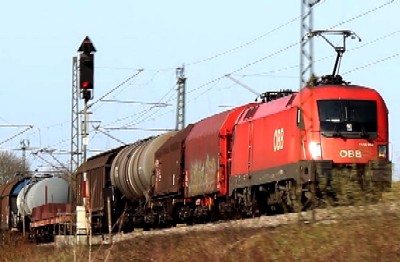 (Österreichische
Bundes Bahn = Austrian Federal Railroad) to purchase the ~25 km rail line from Oberwart north to Friedberg (just over
the state line into Styria), but those plans have changed. Although passenger services between Oberwart and Friedberg were
discontinued in 2011, freight has continued to be transported on the line. Recently, however, it was decided that ÖBB
will remain the owner of the line until at least 2025 and line improvements will be made to support increased freight
traffic. (Österreichische
Bundes Bahn = Austrian Federal Railroad) to purchase the ~25 km rail line from Oberwart north to Friedberg (just over
the state line into Styria), but those plans have changed. Although passenger services between Oberwart and Friedberg were
discontinued in 2011, freight has continued to be transported on the line. Recently, however, it was decided that ÖBB
will remain the owner of the line until at least 2025 and line improvements will be made to support increased freight
traffic. ÖBB is also running a research project on the line that deals with self-driving trains, and this project will continue until 2024. The aim of the project is to reduce the costs of rail transport through digitization and automation.  Sankt
Martin an der Raab Records: We are pleased to announce that Ferenc Zotter's complete transcription of
all 1,853 marriage records and 7,624 death records from 1828 to 1895 for the Catholic parish of Sankt
Martin an der Raab is now available on the BB website. Ferenc is a member of MACSE (Magyar
Családtörténet-kutató Egyesület = Hungarian Society for Family History Research;
https://macse.hu/) and he indexed these records for that society. As
author, he also chose to make his databases available to us, for which we thank him. Sankt
Martin an der Raab Records: We are pleased to announce that Ferenc Zotter's complete transcription of
all 1,853 marriage records and 7,624 death records from 1828 to 1895 for the Catholic parish of Sankt
Martin an der Raab is now available on the BB website. Ferenc is a member of MACSE (Magyar
Családtörténet-kutató Egyesület = Hungarian Society for Family History Research;
https://macse.hu/) and he indexed these records for that society. As
author, he also chose to make his databases available to us, for which we thank him.The source for the data is FamilySearch digital record collection # 4620349, with marriage data here: familysearch.org/search/film/004620349?i=43 and death data here: familysearch.org/search/film/004620349?i=207. Given/first names have been standardized to a single Hungarian form but surnames were transcribed as recorded. Copyright for the transcription remains with Ferenc Zotter. Sankt Martin an der Raab (Hungarian: Rábaszentmárton, Alsóstrázsa) was also the Catholic parish (recording location) for Doiber (Döbör), Eisenberg an der Raab (Vashegy), Gritsch (Grics, Gercse), Neumarkt an der Raab (Farkasdifalva), Oberdrosen (Rábaör, Felsőstrázsa), Welten (Velike) and Windisch Minihof (Tótlak, Kistólak, Kistótlak). The underlined Hungarian names are used throughout the database to identify the villages. You can access these records directly here: SanktMartinAnDerRaabRecords or via our homepage. Ferenc also noted that MACSE has other Burgenland-area records on their website. For example, Civil wedding records: - Frauenkirchen (Boldogasszony): 1895-1920 - Unterzeming (Alsószölnök): 1907-1914 - Kőszeg: 1895-1949 - Szombathely: 1895-1951 - Szentgotthárd: 1895-1910 - Sopron: 1895-1911 And Civil death records: - Farkasdifalva (Neumarkt): 1,357 records - Gyanafalva (Jennersdorf): 3,600 records - Léka (Lockenhaus): 1,901 records - Kőszeg: about 11,000 records - Szombathely: more than 42,000 records As well as Roman Catholic death records: - Kőszeg: 7,000 records He notes that the MACSE website is only partially "English friendly," so he suggests that those interested should contact him. Also, access to the MACSE data is not free-of-charge (the yearly fee is ~$40), but he would be happy to provide more detailed information to help you decide if a subscription is worthwhile. His email address is zotter.ferenc@gmail.com. 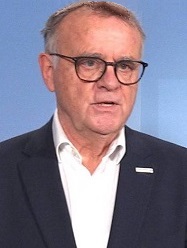 Federal
Presidential Election: Niessl an SPÖ candidate? Former Governor Hans Niessl, looking a little older since I last saw
him, made a recent appearance on Burgenland Heute, part of the Heute (= Today) internet news portal
that targets German-speaking Europe. Federal
Presidential Election: Niessl an SPÖ candidate? Former Governor Hans Niessl, looking a little older since I last saw
him, made a recent appearance on Burgenland Heute, part of the Heute (= Today) internet news portal
that targets German-speaking Europe. Niessl was supporting the call of his successor, Hans Peter Doskozil, that the SPÖ should field its own candidate in the federal presidential election race that will take place later this year. The current Austrian President, Alexander van der Bellen, is an independent, and the current Austrian government is an ÖVP/Greens coalition, with the SPÖ being the strongest opposition party. It remains unknown if van der Bellen will run again, but it is expected that the ÖVP will put up a candidate. Doskozil has said that he would not be such a candidate, leading others in Burgenland to propose Niessl as a candidate from the opposition. When Niessl was asked if he could imagine it, he stated that this was not the time to talk about names (but he didn't rule himself out). So, will we see Hans Niessl in a new political role? Hard to say how strong a candidate he would be in a national election... but he remains popular in Burgenland... and I always liked him. However, Patrick Kovacs tells me that this "...is just part of Doskozil's ongoing feud with [national] SPÖ party leader Pamela Rendi-Wagner. She said that the SPÖ would very likely support van der Bellen if he runs again, so Doskozil naturally had to oppose her publicly." Patrick also notes that, should van der Bellen run again, the ÖVP is very likely to support his candidacy too. But I'll ask the question: what happens if he does not run again?  St.
Margarethen Skeletons: Back last fall, workers in St. Margarethen (Eisenstadt-Umgebung district) found "at least
45 skeletons" while digging a foundation for a new house. The owner of the property, Wolfgang Scheitz, informed the
Federal Monuments Office, as he suspected that it could be an old cemetery. The Monuments Office secured the
find and quickly proceeded to further excavate the site, eventually finding 140 skeletons. The archaeologists were able to
rule out a mass grave or a cholera or plague pit, as the dead had been buried in an orderly manner in four levels. They
initially concluded that the skeletons belonged to a cemetery that had been in use "from the time before the 15th
century," however, they also sent some of the skeletons to the US for dating via the carbon-14 method. That examination
revealed they spanned the 1000-1200 period, which was before the first-recorded mention of St. Margarethen in 1232. St.
Margarethen Skeletons: Back last fall, workers in St. Margarethen (Eisenstadt-Umgebung district) found "at least
45 skeletons" while digging a foundation for a new house. The owner of the property, Wolfgang Scheitz, informed the
Federal Monuments Office, as he suspected that it could be an old cemetery. The Monuments Office secured the
find and quickly proceeded to further excavate the site, eventually finding 140 skeletons. The archaeologists were able to
rule out a mass grave or a cholera or plague pit, as the dead had been buried in an orderly manner in four levels. They
initially concluded that the skeletons belonged to a cemetery that had been in use "from the time before the 15th
century," however, they also sent some of the skeletons to the US for dating via the carbon-14 method. That examination
revealed they spanned the 1000-1200 period, which was before the first-recorded mention of St. Margarethen in 1232.According to the experts, all of this indicates an old, previously-unknown cemetery, and, because cemeteries were near the church in the Middle Ages (usually right next to it or around it), it also indicated a previously-unknown church. What is documented is that the former St. Margarethen castle, which was located some distance from this cemetery, was destroyed in 1289... and they assume this unknown church was also at least partially destroyed at that time. The current parish church (and cemetery) is located on the castle ruins, with the old church likely moved to the ruins of the castle and rebuilt there together with a Karner (ossuary / bone house), which still exists today. The old church location and cemetery were then forgotten. The Federal Monuments Office recently returned the remains to St. Margarethen, where they now rest in the Karner, giving St. Margarethen evidence that extends its documented existence back at least another two hundred years.  What’s
New on GenTeam.at: GenTeam released a "what's new" report in January, indicating records were added in
the following categories: What’s
New on GenTeam.at: GenTeam released a "what's new" report in January, indicating records were added in
the following categories:- House owners in Lower Austria 1751-1755 (new database) - Austro-Hungarian casualty lists, 1914-1919 - Passau Roman Catholic records (.44M marriages, 2M baptisms and 2M burials) - Vienna, Roman Catholic baptisms (many for the Alservorstadt Krankenhaus) - Vienna, Roman Catholic burials (one parish added) - Vienna, Coroner records - RC church registers for Lower Austria, Upper Austria, Styria, Tyrol and Moravia Twelve years ago, GenTeam went online with a total of 1.3 million records. With the latest update, the count has grown to more than 21 million. GenTeam is a free resource but requires a login. 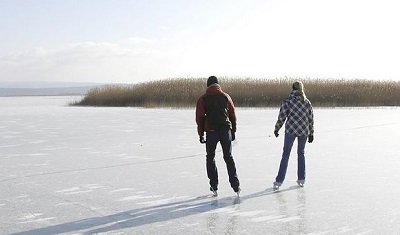 Skating
on Lake Neusiedl? Cold weather in Burgenland has teased those who look forward each year to skating,
hiking or ice-sailing on Lake Neusiedl. However, despite a stretch of low temperatures, the ice layer on the Lake was only a
few centimeters thick during mid-month, much too little for the ice layer to be load-bearing. So, not only was it not
possible to enjoy, it would have been life-threatening; winter sports enthusiasts will have to be patient. Skating
on Lake Neusiedl? Cold weather in Burgenland has teased those who look forward each year to skating,
hiking or ice-sailing on Lake Neusiedl. However, despite a stretch of low temperatures, the ice layer on the Lake was only a
few centimeters thick during mid-month, much too little for the ice layer to be load-bearing. So, not only was it not
possible to enjoy, it would have been life-threatening; winter sports enthusiasts will have to be patient. The last really good winter at Lake Neusiedl was in 2017, when the ice thickness was 20 centimeters or more (7+ inches) on the lake, more than enough for skating or hiking. That year the season lasted a good six weeks until the ice became too thin to trust. Since then, there have been little or no opportunities to explore and play on a frozen Lake. PS: Late last month there was an article about a "polar bear plunge" type event at the Lake ...and there was no ice! Burgenland Government Commits To Building Social Housing: The Province of Burgenland has committed to providing at-cost social housing, with the first apartments to be built in all seven districts before the end of the year. The state real estate company has been commissioned with the planning, tendering and implementation of the project via a new but yet-to-be-founded subsidiary. 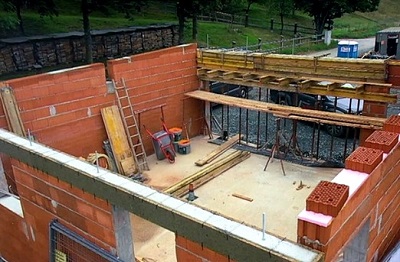 All who
meet the eligibility requirements for housing subsidies are entitled to rent such a state apartment. What is new is
that the tenant can also buy the apartment at the construction price at any time, with any rent paid deducted
from the purchase price. The future buyer will know the value of the property right from the start. The initial apartments
are to be built in three sizes, 40, 70 and 100 square meters (430, 753 and 1076 square feet). All who
meet the eligibility requirements for housing subsidies are entitled to rent such a state apartment. What is new is
that the tenant can also buy the apartment at the construction price at any time, with any rent paid deducted
from the purchase price. The future buyer will know the value of the property right from the start. The initial apartments
are to be built in three sizes, 40, 70 and 100 square meters (430, 753 and 1076 square feet).The announcement immediately met criticism from the opposition ÖVP party, which called the social housing plan "uncontrolled nationalization" and an attempt to make Burgenländers dependent on the government. The Green party, however, saw the announcement as "fulfilling" one of their central demands: that housing cooperatives must not make a profit from apartments financed by taxpayer money. Editorial comment: This idea of selling at construction cost, however, is not without concerns. In the US, Habitat for Humanity, which builds similar housing for low-income families, recognizes that such a plan can encourage unscrupulous individuals to attempt to buy the house from the financially-naive new owner for more than the construction cost though less than its full market value, thereby offering the new owner immediate cash yet providing a nice profit for themselves. Habitat counters that by requiring the new owner to take out two mortgages: one for the construction cost and one for the then-difference between market value and construction cost. The owner pays the construction-cost mortgage each month and is credited a proportional amount of the difference mortgage. If the owner sells before the mortgages are fully paid/credited, the full remainder of both mortgages is owed to Habitat, with any additional profit (increase in market value) or loss going to the owner. Whether Burgenland is implementing a similar payoff scheme was not clear from the news story... but I think it is a necessity.  Corona
Virus in Burgenland: Austria continues with no entry restrictions for travelers arriving from the
United States other than a proof of vaccination, proof of recovery from COVID-19 or a negative Covid-19 test result that
must be presented upon entry. Corona
Virus in Burgenland: Austria continues with no entry restrictions for travelers arriving from the
United States other than a proof of vaccination, proof of recovery from COVID-19 or a negative Covid-19 test result that
must be presented upon entry.In Burgenland, Governor Hans Peter Doskozil presented a package of measures for the Omikron variant that focuses on increased testing and vaccination. For critical infrastructure, such as nursing homes, hospitals, the state holding company and the state government, increased Covid testing was to be carried out daily starting Monday, January 10th, and continuing for at least four weeks: - Both vaccinated and unvaccinated workers are required to take an antigen test every day; - unvaccinated workers must additionally take a PCR test three times a week, which is valid for 48 hours; - vaccinated workers in nursing homes or hospitals are required to take a PCR test twice a week, which is valid for 72 hours; - vaccinated workers in the state government or the state holding company must take a PCR test once a week, which is valid for 48 hours. These testing options were also made available to companies that are considered critical infrastructure, with 15 of the 16 companies agreeing to do so. Doskozil also wanted to implement extended testing in the schools but the Ministry of Education vetoed the idea. However, as previously planned, all students had to have a PCR test before returning to school on January 10th. In order to accommodate increased PCR testing, Burgenland, in cooperation with pharmaceutical company Sanochemia, set up its own laboratory that will be able to perform 21,000 tests per week. Other laboratories remain open and testing can still be done via pharmacies or available home "gargle" tests. As for vaccination, another voluntary program is underway that will offer vaccines in every municipality in Burgenland. That began January 18th and will supplement existing resources for vaccination. As for the Austria-wide compulsory vaccination, scheduled to begin in February, discussions continued. Doskozil and his SPÖ absolute-majority Burgenland government submitted a formal statement to the Austrian federal government that did not speak against compulsory vaccination but was concerned with how the draft law implements it. The concern is for the large number of administrative criminal proceedings that may occur for violations of compulsory vaccination, which would be a burden for administrative authorities. It argues that there are more lenient means to increase the vaccination rate, such as a vaccination lottery like Burgenland implemented, or fee-based, required coronavirus tests, where the cost could be use to persuade more people to vaccinate. Further, it doubts whether administrative proceedings could move quickly enough to persuade larger groups of people to be vaccinated. However, Doskozil also said his party will not vote against the measure. The minority Green party spokeswoman, Regina Petrik, believes there is no alternative to compulsory vaccination but indicated that internal debate continued within her party. Even Catholic Diocesan Bishop Ägidius Zsifkovics was drawn into the discussion on compulsory vaccination. Zsifkovics contracted Covid-19 last autumn, despite being vaccinated, and still suffers from mild long-term consequences such as fatigue and pain in the ribs. While he believes the announced mandatory vaccination against the coronavirus is justifiable as an extreme remedy, he also believes that more lenient means, such as increased education about the vaccine, should be chosen. He also argues against political ideology and fear-mongering. "It is incomprehensible that, in such a situation, one no longer seeks what is common but tries to make political capital out of it. The common enemy should not be other parties but the virus. That should be combated. Whoever loves Austria does not divide it." On the 20th of January, the Austrian National Council (lower house of Parliament) approved the measure, with fines up to €3600 for noncompliance. The Federal Council (upper house) will vote February 3rd. While the Federal Council can veto the measure, the National Council can override a veto with a revote. Doskozil did get his vaccination lottery idea added to the measure, one with 1-in-10 chance of winning €500 if you are vaccinated. There is also a financial incentive system for the municipalities: with a nation-wide vaccination rate of 80 percent, 75 million euros will be distributed, at 85 percent it is 150 million, and at 90 percent, 300 million euros will be split. 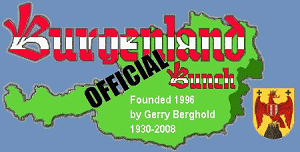 The
Facebook Bunch (from Vanessa Sandhu): The
Facebook Bunch (from Vanessa Sandhu):Greetings, Burgenland Bunch! I hope that everyone is doing well! We had a great month in our Facebook group. We welcomed 36 new members, bringing our total membership count up to 1,793 strong. If we are still missing you, please come join us! facebook.com/groups/TheBurgenlandBunchOFFICIAL/ BB Staff Member Bob Strauch shared 2 great music links: -- “Neujahrslied” (by Neujahrgeiger from Naas, Steiermark) youtube.com/watch?v=fgIwzDuX_28 -- “Neujahrswalzer” (by Peter & Ingrid Krones from Göttelsberg, Steiermark) youtube.com/watch?v=eF7cZwzpLUc We rang in the New Year with our own Alex Meixner, playing “Neu Jahr Wunsch” on his Munda accordion. m.youtube.com/watch?fbclid=Iw...feature=youtu.be Member Karl Sarkozi states: “FYI: If anyone is looking for birth records from the 18th century from Badersdorf, there are many entries in the register book for Hannersdorf on Matriken.at. Later stuff after 1797 (I believe) switches over to Kirchfidisch.” Member William K. Arthofer responded that Mischendorf also kept records for Badersdorf, but Karl observed that there are some Badersdorf entries in Hannersdorf. Member Janet Kroboth-Weber shared a link to a Burgenland atlas, showing a nice antique map of the region: atlas-burgenland.at/index.php...Itemid=101... Janet also shared a link to the song “Mein Burgenlandermäderl”, as performed by the MusiBanda Gramüposcha group. m.youtube.com/watch?v=5...p9E BB Staff Member Patrick Kovacs shared his updated house list for Kleinzicken with DOB, DOD and spouses. -- geni.com/projects/Kleinzicken/4481599 -- the-burgenland-bunch.org/HouseList/OW/Kleinzicken.htm CONNECTIONS: (there are many this month!) Member Agnes Fazekas writes “Hello... maybe this is how I can get my relatives in South Bend, Indiana to be found... or to learn something about them. They are called Jordanich and Crismanich..... Migrated from Kroatisch Minihof.. Isadore and Agnes Jordanich.... the children and grandchildren of both... and great-grandchildren. Thank you!!!” Member Karl Sarkozi is searching for others researching the TSOMAN / ZOMAN / ZOGMANN family from Badersdorf. Member Julia Gottberg is looking for any relatives in Eltendorf. She writes “My grandmother was Julia Zodl. I visited their farm as a teenager 50 years ago.” Member Siegfried Wolf is searching for relatives of Carl L. Wolf, born 1 Jan 1913 in Connecticut, died 10 Aug 2001 in Raleigh, NC. It appears that Carl had no children, but his extended family was quite large. His father, Rudolf Wolf, was the son of Michael Wolf. Rudolf had 15 siblings. Michael Wolf was from the village of Mühlgraben, (Jennersdorf / Burgenland) and migrated in the year 1889 to New Britain with his first wife Josefa Uitz Wolf, who died at New Britain. Michael Wolf married his second wife Rosina Preininger Wolf at New Britain. Michael’s children were Robert, Charles, Emilie, William, Rosina, Ida, Paulina, Johanna, Hermann, Berta, Michael, Ludwig, Rudolf, Stefanie, Theresia, and Emma Wolf. Member Joanne Juhnke writes: “I am working on tracing my husband's side of the family. His great-grandfather (his father's mother's father) Samuel ARTNER was born in Dreihütten, 18 Sep 1871. Samuel ARTNER married Anna ZAPFEL, b. 1876, of Stadtschlaining, and fathered 3 children (August b.1899, Joseph b.1901, and Herman b.1903) with her in Stadtschlaining before emigrating to Chicago in 1903. Anna and the 3 kids followed him to Chicago in 1909, along with a nephew of Samuel ARTNER's (Samuel BOGAT). That ship list includes an entry for Anna's next of kin in Stadtschlaining, her father Samuel ZAPFEL. They had 4 more children in the US -- Louise [my husband's grandmother], Anna, Ella, and Walter. I understand that a number of ARTNERs of Samuel's generation are buried near him in St. Luke's cemetery in Chicago, but no idea how they connect. Any connections welcome, and thanks again." -- Joanne in Madison, Wisconsin If anyone would like to connect with Agnes, Karl, Julia, Siegfried, or Joanne, please contact me at HooftyRN@msn.com and I will be happy to put you in touch! BB Staff Member Patrick Kovacs has uploaded his parent’s DNA to Ancestry.com and MyHeritage. He is sharing this information so others can cross-check their results to see if there is any relation to his family. Match names would include Gerald Kovacs, Christine (née Schrei) Kovacs, Johann Kovacs, and Herta (née Pumm) Kovacs. Patrick’s family hails from southern Burgenland (specifically Oberwart, Güssing, and Jennersdorf). If you are a match and would like to contact Patrick, please email him @ patrick.kovacs@the-burgenland-bunch.org. That is all for this month! Take care and stay safe and healthy! Vanessa  Update
for book "The Burgenländer Emigration to America": Here is this month's update on purchases of the English issue of
the 3rd edition of Dr. Walter Dujmovits' book "Die Amerika-Wanderung Der Burgenländer." Update
for book "The Burgenländer Emigration to America": Here is this month's update on purchases of the English issue of
the 3rd edition of Dr. Walter Dujmovits' book "Die Amerika-Wanderung Der Burgenländer."Current total sales are 1635 copies, as interested people purchased 8 more books during this past month. As always, the book remains available for online purchase at a list price of $7.41 (which is the production charge for the book, as we purposely choose not to make a profit so we can avoid dealing with the income tax consequences and so you can obtain the book at as low a cost as possible!), plus tax & shipping. See the BB homepage for a link to the information / ordering page and for information about current discounts (there is at least one discount on price or shipping available most of the time... if not, wait a few days and there will be one!). The book is an excellent read for the Burgenländers in your family. Burgenland Recipes: This month's recipe is from Cathy Bourner, whose great grandmother was from Mönchhof. Unfortunately the family's recipes have been lost, but they were quite similar to some of the "German Dishes" featured in Country Gentleman Magazine of Philadelphia in January 1936, and those were preserved by Cathy's great aunt.  Plum Cake (Pflaumen Kuchen)
Plum Cake (Pflaumen Kuchen) (from Cathy Bourner) Ingredients-dough: 1 cake of compressed yeast 2 cups of barely lukewarm water 1/2 cup sugar 1-1/2 tsp. salt 2 eggs 6 cups bread flour 1/3 cup butter up to 1/4 cup shortening (to grease pans) Ingredients-plum topping: 2 cups of canned plums 1/2 cup sugar 1 cup sour cream 1 egg 2 Tbsp. flour approx. 1 Tbsp. sugar, held in reserve Preparation: Crumble the yeast into 2 cups of lukewarm water and add 1/2 cup sugar, 1-1/2 teaspoons salt and 2 well-beaten eggs. Blend. Then measure out 6 cups of flour. Add half of it to the yeast mixture together with 1/3 cup melted butter. Beat hard. Mix in the rest of the flour. Knead for a few moments until the dough is smooth. Let the dough rise in a covered bowl until it doubles in bulk, about 2 hours. Punch it down and let it rise until it doubles again in bulk. Pat or roll the dough out to 1-inch thickness, then transfer it to a floured pie plate or greased cake pan. Alternately, form the dough into an oblong loaf to fit a long greased loaf pan, or make into smaller round loaves and fit into greased pie pans (Ed. large cupcake tins?). Dot loaves with 2 cups of canned plums which have been seeded and cut into pieces. Make a sauce by mixing 1/2 cup sugar, 1 cup sour cream, 1 beaten egg, and 2 tablespoons of flour. Spread the sauce carefully onto the plums and loaves. Let loaves rise until very light. Sprinkle with sugar, and bake in a moderate oven (375 degrees F) for 40-45 minutes. Notes: Cut into wedge-shaped pieces or oblongs and serve hot or cold.  Note:
Our recipes sortable list has links directly to the recipes or food-related articles published
in our past newsletters. You can access the list by clicking our recipe box (to the right). Thanks to the contributions of
our members over the years, we have quite a collection of Burgenland recipes, some with several variations. Note:
Our recipes sortable list has links directly to the recipes or food-related articles published
in our past newsletters. You can access the list by clicking our recipe box (to the right). Thanks to the contributions of
our members over the years, we have quite a collection of Burgenland recipes, some with several variations.However, we have now used up our unpublished recipes... thus this recipe section will be dormant whenever we have no recipe to publish. So, if you have a favorite family recipe, please consider sharing it with us. We will be happy to publish it. Our older relatives, sadly, aren't with us forever, so don't allow your favorite ethnic dish to be lost to future generations. You can send your recipe to BB Recipes Editor, Alan Varga. Thanks! Cartoon of the Month: 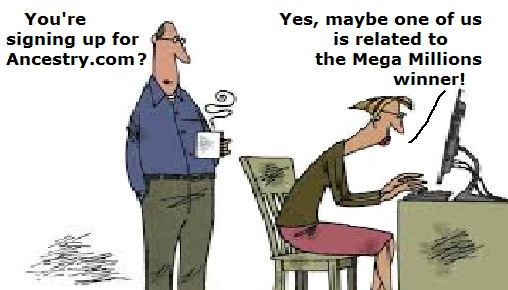 |
2) BURGENLÄNDERS IN CHICAGO (by Tim Hermesdorf) 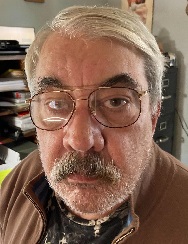 It
is estimated that between thirty and sixty thousand Burgenländers came to Chicago starting the 1880s [1]. Readily
available references, though, do not provide enough detail to fully appreciate where these individuals settled within the
city limits. The Encyclopedia of Chicago, 2004 edition, under the heading of Austrians, provides a vague,
incomplete, and possibly inaccurate picture of Burgenländer settlement. Dr. Walter Dujmovits, in his seminal book,
The Burgenländer Emigration to America, only discusses one of the major enclaves in the Chicago area. It
is estimated that between thirty and sixty thousand Burgenländers came to Chicago starting the 1880s [1]. Readily
available references, though, do not provide enough detail to fully appreciate where these individuals settled within the
city limits. The Encyclopedia of Chicago, 2004 edition, under the heading of Austrians, provides a vague,
incomplete, and possibly inaccurate picture of Burgenländer settlement. Dr. Walter Dujmovits, in his seminal book,
The Burgenländer Emigration to America, only discusses one of the major enclaves in the Chicago area.Therefore, the purpose of this paper is to better describe and more fully define the Burgenländer presence in the “Windy City.” To achieve my goal, I used the following references: • United States Census records • Ellis Island records • Social Security Index records • Naturalization records • Roman Catholic Archdiocese of Chicago records • Hungarian Church records, 1860 to 1895 • Hungarian Civil records, 1895 to 1920 • Burgenland Bunch website There are several barriers to the task of enumerating the Burgenländer population of Chicago. Since there was no territory defined as Burgenland until 1921, individuals identified themselves as Hungarian or Hungarian-German on documents. After the annexation to Austria, they tended identify as Austrians. Therefore I cannot quantify exactly how many persons actually came from Burgenland but, based on tracing individual families to the old world plus the fact that over 60% of Austrian immigrants hail from Burgenland, I believe the numbers are fairly indicative of the Chicago Burgenländer presence [2]. Another road block concerns the 1890 U.S. Census. It is generally accepted that our ancestors began arriving in the city around 1880. The 1890 Census would be most helpful in determining where they lived. Unfortunately, the documents were largely destroyed by fire and are unavailable [3]. What follows are determinations I could make from the available sources. If you are not familiar with Chicago, the citizens tend to call themselves Northsiders or Southsiders. Seldom, until the 1990s, did families move across the imaginary line that separates the two. Immigrants from practically all ethnicities followed this pattern, and Burgenländers were no exception. I found two distinct populations with differing characteristics. I will therefore cover each separately. Southside The Encyclopedia of Chicago describes a “Little Burgenland” that they claim grew up along what is now the Burlington Northern and Santa Fe railroad tracks. Unfortunately, I found nothing to support this. Church and census documents lack any indication of a Germanic population along the corridor. Dr. Walter Dujmovits mentions a Little Burgenland but does not give a specific location [4]. A more definitive description is found in The Burgenland Bunch Newsletter [5], which cites a 1955 trip report by Dr. Norbert Reidl, then director of the Burgenland State Museum. 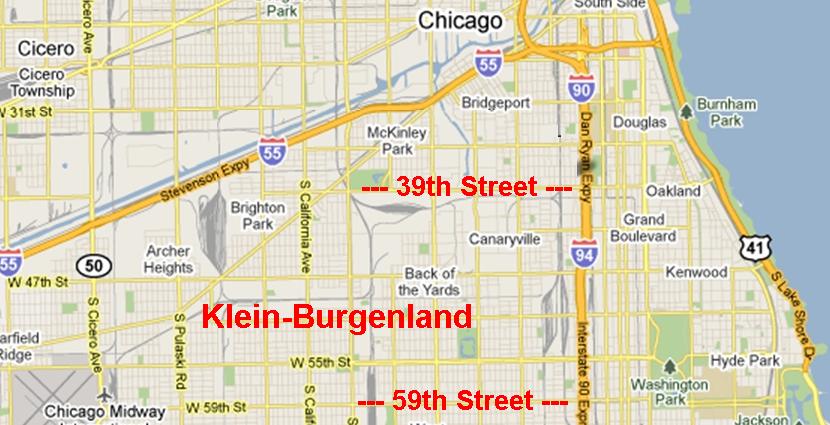 According
to Reidl and the BB-generated map in that newsletter (see image to the right), the boundaries of Little Burgenland
were roughly 39th Street (now Pershing Road) on the north, 59th Street on the south, California Avenue (2800 west) on the
west and to Perry Avenue (100 west) on the east (Perry Avenue, north of 55th, is now known as Federal Street). According
to Reidl and the BB-generated map in that newsletter (see image to the right), the boundaries of Little Burgenland
were roughly 39th Street (now Pershing Road) on the north, 59th Street on the south, California Avenue (2800 west) on the
west and to Perry Avenue (100 west) on the east (Perry Avenue, north of 55th, is now known as Federal Street).These are not strict boundaries but a general description. The majority of houses on some blocks were occupied by families identifying as Hungarian, Hungarian-German, Croatian or Magyar. Based on a limited survey of surnames, for which I cross-referenced names found in census records for the neighborhoods in question with the corresponding family origin locations found via FamilySearch.org [6], many were definitely Burgenländers. Why the did this location attract them? I believe the answer is twofold. Using Ellis Island ship manifests, a majority of our folks listed their professions as either laborer or farm worker/hand; in other words, they had few skills. The late nineteenth and early twentieth century saw a massive increase in heavy industry on the Southside versus the Northside, The Union Stockyards, steel mills, railroads and other heavy manufacturing provided ample job opportunities. It was only natural that Burgenländers were attracted there along with other newcomers. As early as 1920 and continuing to 1940, another trend emerges. All ethnicities, including our own, started to move to the southwest. I can only assume that better housing, more space and freedom from pollution were some of the factors behind this. In the process, Burgenländers became harder to track. They spread out over a wider geographic area. As the first American-born generation came of age, their places of birth are now listed as Illinois. Lastly on the 1940 census, the columns listing parents' places of birth were eliminated. In spite of these limitations, the data in the "Burgenländers Honored and Remembered" pages [7] gives ample testimony to our people’s presence. Northside The pattern of Burgenländer settlement here differs considerably versus the Southside. The readily-available sources mention little. In reality the Burgenländer population was considerable. Perhaps the impression the Northside was not a destination for them is due to the fact that Burgenländers integrated with the existing and sizable German population. A brief discussion of German settlement in the Windy City may help to explain why our people were attracted there. The City of Chicago was incorporated as a city in 1837, with an approximate population of four thousand souls. Germans came here as early as 1838. The German presence grew especially in the 1850s, to the point where Germans were the largest ethnic group in the city. While there were Germans on the Southside, there was no concentration remotely comparable to that of the Northside. A reason that explains this is found in the Ellis Island manifests. Unlike other groups, whose listed professions suggested they were unskilled, Germans tended to be tradesman with marketable abilities. Considering that Chicago grew from approximately 4,000 in 1837 to 109,260 in 1860, it is safe to assume that tradesmen with construction skills were in high demand. This would also explain why Germans did not feel the need to live near heavy industry. Germans were characterized by a strong desire to preserve their language, history and culture. Naturally they would try to establish a community to serve those needs. The area that would become the "German neighborhood" was not annexed to the city until 1853, coinciding with the intense German immigration occurring at the time [8]. I assume that this neighborhood allowed for new construction and increased occupancy versus other parts of the city. 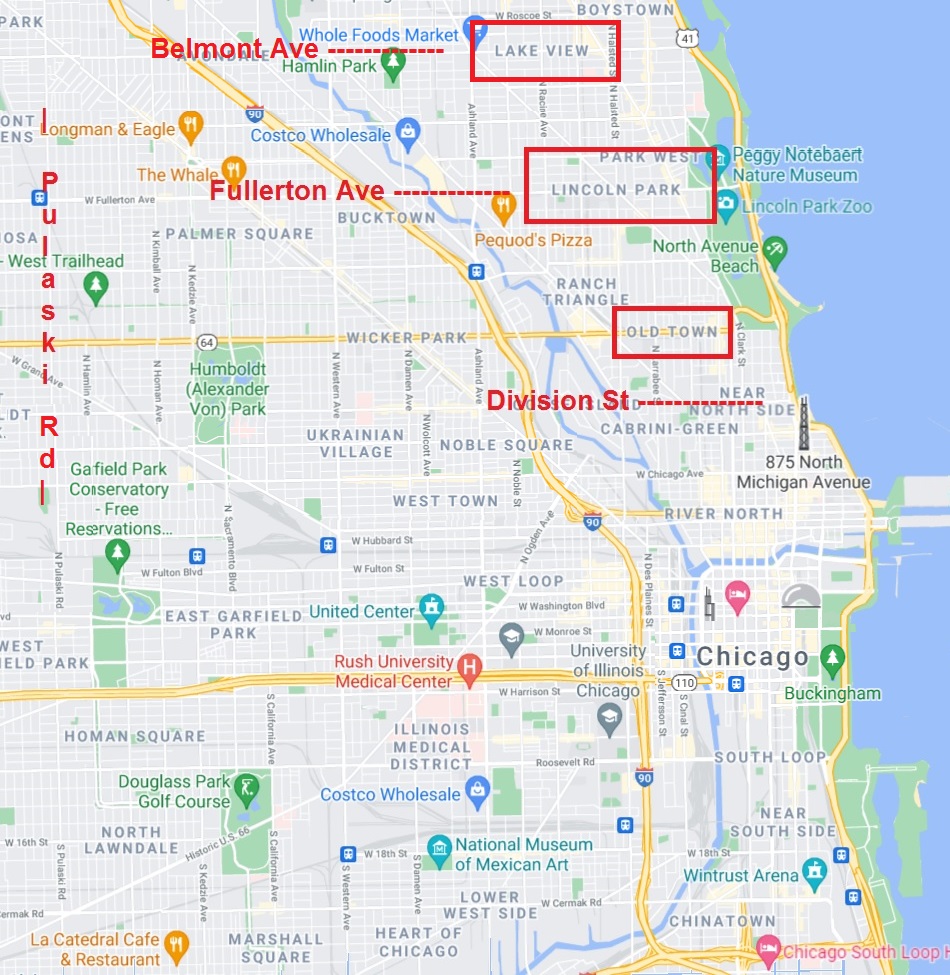 With
time, the German neighborhood would extend roughly from Division Street (1200 north), to Belmont Avenue (3200 north),
and from Halstead Street (800 west) on the east, to the North Branch of the Chicago River on the west. This
area is now referred to, going south to north, as Old Town, Lincoln Park, and Lake View. This would
also become an area of intense Burgenländer occupancy, although for reasons that elude me at this time, our folks
tended to stay south of Fullerton Avenue (2400 north). With
time, the German neighborhood would extend roughly from Division Street (1200 north), to Belmont Avenue (3200 north),
and from Halstead Street (800 west) on the east, to the North Branch of the Chicago River on the west. This
area is now referred to, going south to north, as Old Town, Lincoln Park, and Lake View. This would
also become an area of intense Burgenländer occupancy, although for reasons that elude me at this time, our folks
tended to stay south of Fullerton Avenue (2400 north).This situation would obviously attract Burgenländers, since language, customs and recreation were familiar. There was an added attraction. A large number of Chicago Deutsch were Roman Catholics. Feeling disserved by the largely-Irish Diocese of Chicago (Archdiocese after 1843), they hired clergy and built their own parishes. In other words, Burgenländers could worship and send their children to parochial schools where a language they understood was spoken. Census records give ample evidence of our presence. Occupants of several houses in a block listed themselves as Hungarian. Cross-checking surnames between Hungarian and Ellis Island documents attest to the fact they were Burgenländers. There are some other items of note. Much of the housing was multi-family. Extended families sometimes lived in the same dwelling or close by. Families from the same village or district frequently lived in close proximity to one another. Obtaining a true sense of the Burgenländer population requires a line-by-line audit of the censuses. This is a task that, at least at this time, I am unable to perform. In an attempt to gain a sense of the Burgenländer population, I turned to the Chicago Archdiocesan records. Unfortunately, there are difficulties in this approach. None are available on line after 1919. There are considerable inconsistencies between parishes. Some list the barest information, others are more detailed. A particularly good source is St. Michael’s in Old Town. I specify Old Town because there are three St. Michael parishes in the city. A survey of the marriage register for sample years reveals the following percentages of all marriage candidates that identified as Hungarian. • 1904 10% • 1905 25% • 1906 27% • 1907 67% • 1908 39% • 1909 59% • 1910 64% Admittedly, identification as Hungarian in a German-speaking church is not proof-positive that all the persons were Burgenländer but, given the high proportion of our people that immigrated from the future Burgenland to Chicago (as mentioned in other sources, e.g., Dujmovits, p137 [4]), lends credibility to the assumption that many of the above were indeed from our land of origin. A considerable number of Burgenländers are also found west and northwest of Old Town. Hardly as prominent a number as in the older neighborhoods but definitely definable to an extent. There, our people lived side-by-side with other ethnicities, especially Scandinavians. My guess as to the reason for this is the possible lack of housing further east. This, the southeast corner of Jefferson Township, was annexed to Chicago in 1889. The area I am referring to is west of the river to at least Pulaski Road (4000 west), called Crawford Avenue at one time, and from Division Street (1200 north) to Fullerton Avenue (2400 north). Mirroring the Southside, Northside Burgenländers moved further northwest in ensuing years. The same difficulty in assessing locations presents as it did on the Southside; namely loss of information on ethnicity. I did find one identifiable cluster farther to the northwest centered around St. Philomena parish. This too was a German ethnic parish founded in 1888. Closing Certain points should be made. I commented that many if not most Burgenländers that came to America were unskilled. Sequential data show that they did not stagnate. Ample evidence exists that our folks entered trades and improved their lot over the years. Other signs of improved economic status were the rise in single family homes owned by Burgenländers and movement to areas with higher property values. Although a majority of Burgenländers lived side-by-side with other ethnic groups, especially Germans, they maintained their unique identity. A number of Burgenland associations flourished in Chicago. While an accounting of these organizations is a subject unto itself, it is worthwhile to note that Dr. Reidl [5] stated that "The 'Eichenstamm' society dominated northern Chicago, while the 'Ersterburgenländischer Krankenunterstützungsverein' operated mainly in southern Chicago. Later on, a third Burgenländer society was established in western Chicago." The indicated locations of these associations support the evidence I found for the several distinct Burgenländer enclaves. Lastly, my goal was to better define the Burgenländer presence. I do not, by any means, consider this to be the end-all of the discussion. My hope is others might use this as a starting point for further research. My conclusions may be challenged and I look forward to a lively exchange concerning them. References 1 Die Presse, 21 Oct 2009 2 https://www.austrianinformation.org 3 https://www.archives.gov/publications/prologue/1996/spring/1890-census-1.html 4 Dujmovits. The Burgenländer Emigration to America, page 137-8 5 Burgenland Bunch Newsletter #204, 31 Oct 2010, article 3c (Newsletter204.htm#03) 6 https://www.familysearch.org/search/ 7 https://www.the-burgenland-bunch.org/BH&R/il-home.htm 8 https://www.encyclopedia.chicagohistory.org/pages/520001.html TIm Hermesdorf is a retired firefighter/paramedic living in Aurora, IL. He joined the BB while searching for his mother's roots. Her parents were Franz Panny (Banny in the US) from Tudersdorf and Cristina Prisching of Allersdorf. It was his grandparents' immigration to Chicago that spurred his interest concerning Burgenländers in Chicago. Editorial note: Tim's research has continued since completing the above article. His current efforts are centered on tracking Chicago-identified individuals found in BH&R. The early stages of this continuing research has confirmed what he said in the article while also indicating some stretching of the above-identified enclaves into neighboring areas. |
3) STUBITS REUNION—THROUGH WILLIAM IGNATIUS STUBITS (1932-2021) (by Helen Stubits Yeager) 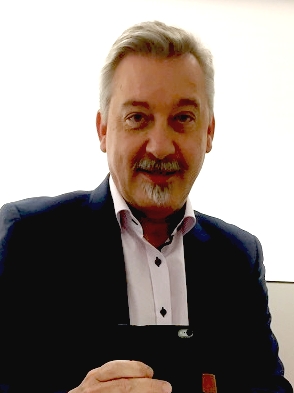 Editorial
note: I recently received an email from BB member Werner Stubits, of Perchtoldsdorf, Austria, where he informed
me that one of our members, William Ignatius Stubits, a cousin of his father, Philipp, had died in 2021 and that it
would be appropriate for us to edit our entries for William to recognize his death (which we have done). William Stubits was
born 22 Oct 1932 in Northampton, PA, died 14 Oct 2021 in his home in Chalfont, PA, and was, as Werner stated, "the most
important person to re-establish our family connections over the ocean," which is why Werner knew of his death. As such,
Werner said that he would "...love to find him on the remembrance list." By that, he meant the BB Burgenländers
Honored & Remembered list... but I had to tell him that BH&R is only for Burgenland-born individuals who die elsewhere
(i.e., emigrants). Editorial
note: I recently received an email from BB member Werner Stubits, of Perchtoldsdorf, Austria, where he informed
me that one of our members, William Ignatius Stubits, a cousin of his father, Philipp, had died in 2021 and that it
would be appropriate for us to edit our entries for William to recognize his death (which we have done). William Stubits was
born 22 Oct 1932 in Northampton, PA, died 14 Oct 2021 in his home in Chalfont, PA, and was, as Werner stated, "the most
important person to re-establish our family connections over the ocean," which is why Werner knew of his death. As such,
Werner said that he would "...love to find him on the remembrance list." By that, he meant the BB Burgenländers
Honored & Remembered list... but I had to tell him that BH&R is only for Burgenland-born individuals who die elsewhere
(i.e., emigrants).Werner also noted that William's daughter, Helen Stubits Yeager, had visited Burgenland in 2019, prompting him to organize a family reunion for the occasion and, later, for Helen to write an article about that reunion. Werner, a board member for the researcher community ÖFR (Österreichische Gesellschaft für Familien- und regionalgeschichtliche Forschung = Austrian Society for Family and Regional Historical Research), arranged to have the article included in the Society's recently-published yearbook (along with another article about the Bugnitz/Bugnits family, whose origins are in the same village as the Stubits: Harmisch). I, of course, passed along my sympathies to the greater Stubits family but also inquired whether it might be appropriate to republish these articles in the BB Newsletter. Werner replied that it would be appropriate, and he quickly contacted the authors to obtain permission for us to reprint their articles. So what follows is the Stubits story. I'll publish the Bugnitz story in next month's newsletter. I offer my thanks to Werner and to the authors for making these articles available to us. Werner notes that ÖFR's website is here: www.oefr.at; and their Wiki here: https://wiki.oefr.at. The website includes a section for research in the Burgenland / former Hungary region: https://oefr.at/2020/ahnenforschung-im-burgenland. So on to Helen's story... Stubits Reunion—through William Ignatius Stubits (1932-2021) - by Helen Stubits Yeager 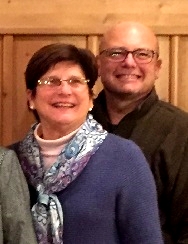 My
father’s parents came from Austria to Northampton, PA, where a number of my father’s mother’s family (Keglovits)
lived—and many still live in that area, though many of the younger people have moved away. Northampton was an
Austrian-Hungarian small town where many of the folks spoke Hungarian, German or a mix. My
father’s parents came from Austria to Northampton, PA, where a number of my father’s mother’s family (Keglovits)
lived—and many still live in that area, though many of the younger people have moved away. Northampton was an
Austrian-Hungarian small town where many of the folks spoke Hungarian, German or a mix.My dad’s aunts and uncles in America kept in touch via mail with the Austrian relatives and would share the news of family events. My father always knew he had relatives in Austria, but he had never met them. In 1972, my parents won, through a church raffle, a trip to Europe or $2000. They decided to take the $2000 and make their own trip to Europe in 1973. Austria was one of the countries they visited and, when in Vienna, they looked through phone books for Stubits and called every one of them until they reached Stephan (my father's cousin). Stephan met my father and mother at the train station (despite the fact they have not seen each other ever before), and he invited them to meet the rest of the family. They had such a good time and came back home and told everyone about the trip. In 1974, as a graduation gift, I and a friend went to Vienna for 3 weeks. We stayed with my dad's cousin Ida and her husband Max, and they and Stephan took us all over Austria and Yugoslavia, where we visited my mother’s family in Murska Sobota, which is now in Slovenia. The reason they gave me the trip was that I had completed four years of German and it would be a good experience. The reason I took German was because, when my parents didn’t want us to know something, they would speak in German, not English, so I thought I would be able to understand their “secrets” ...but little did I know that they spoke the Austrian dialect and I spoke high German. Through the years, several trips to Vienna and Harmisch were made and the Austrian relatives came to the US. My father would show the family various cities across the US, and he was so proud and happy to take the American relatives to meet the Austrian relatives. Those visits with his relatives were some of my Dad’s happiest times—he so enjoyed the camaraderie and really felt at home. Every holiday we would get phone calls from various folks in Austria, keeping us up on the family news. In early 2000, my sister June, her son Tyler, my Dad and I traveled to Austria and had the opportunity to show my nephew the cemetery in Harmisch and the area all 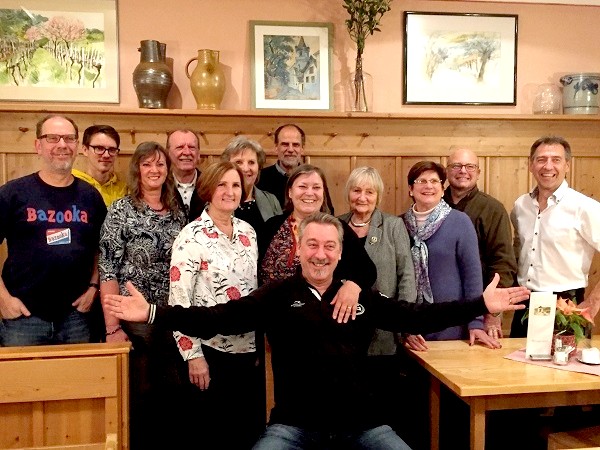 his
ancestors grew up in. When my husband and I traveled to Austria in late 2019 to visit the Christmas markets, Werner arranged
a family gathering. It brought back so many memories, seeing people from different times in my past. his
ancestors grew up in. When my husband and I traveled to Austria in late 2019 to visit the Christmas markets, Werner arranged
a family gathering. It brought back so many memories, seeing people from different times in my past.Our friends are so amazed that we know our relatives outside of the US, and make us realize how lucky we are to know, not only the people, but our heritage—something we should take advantage of. During the holidays and family events, we still eat the foods, especially the pastries from what we call “the old days” when were children. Those have become blended for us since my American aunts are Austrian, Hungarian and Czechoslovakian... but they still bring back memories and are delicious. Helen Stubits Yeager recently moved to Hilton Head, SC, from the Philadelphia, PA, suburbs. She is a descendant of Stubits in Harmisch, Burgenland, and Kalamars in Murska Sobota, Slovenia. Helen grew up in an extended family honoring the Burgenland traditions, food and language. Her first trip to Austria was in 1974 and her most recent one in 2019. Helen has retired from 30 years in the information technology industry and is enjoying the sun, water and beautiful weather in South Carolina with her husband. She and her cousins continue to carry on the traditions defined by their parents and grandparents. |
4) HISTORICAL BB NEWSLETTER ARTICLES Editor: This is part of our series designed to recycle interesting articles from the BB Newsletters of past years. The entry below, from 10 year ago, was passed along by the now deceased Gary Gabrich, but the sentiment remains alive. THE BURGENLAND BUNCH NEWS No. 217 January 31, 2012 THE CHOSEN (by Della Cummings Wright) Ed Note: BB Member Gary Gabrich passed along the following essay, found on the Appanoose County, Iowa, GenWeb site (http://iagenweb.org/appanoose/index.html), Jeanette McFarland, Coordinator. Gary writes: "Friends, I ran across this opening page of a county GenWeb site in Iowa and was moved by the article, 'The Chosen.' It brings to life the thoughts I have on my genealogy hobby but could not express as eloquently as stated by Della Cummings Wright. I bet you all feel the same."
|
5) ETHNIC EVENTS LEHIGH VALLEY, PA Friday, Feb. 4: Grundsau Feier at the Lancaster Liederkranz. Music by the Grundsau Kapella. Info: www.lancasterliederkranz.com Sunday, Feb. 6: The Steelworkers at the Coplay Sängerbund. Info: www.coplaysaengerbund.com Friday, Feb. 11: Kermit Ohlinger at the Reading Liederkranz. Info: www.readingliederkranz.com Saturday, Feb. 12: Fasching at the Lancaster Liederkranz. Music by The Continentals. Info: www.lancasterliederkranz.com Saturday, Feb. 12: Fasching at the Evergreen Heimatbund in Fleetwood. Music by Maria & John. Info: www.facebook.com/evergreengermanclub/ Sunday, Feb. 20: The Josef Kroboth Orchestra at the Coplay Sängerbund. Info: www.coplaysaengerbund.com Friday, Feb. 25: Kermit Ohlinger at the Reading Liederkranz. Info: www.readingliederkranz.com Saturday, Feb. 26: Fasching at the Reading Liederkranz. Music by The Adlers. Info: www.readingliederkranz.com Saturday, Feb. 26: Lumpenball at the Lancaster Liederkranz. Music by The Alpenländers. Info: www.lancasterliederkranz.com Saturday, Feb. 26: Button Box Night at the Ss. Peter & Paul Society (Hungarian Hall) in Northampton. Music by the Button Box Committee. Info & Reservations: (610) 261-9131 or (610) 653-0081. www.facebook.com/pg/Northampton-Hungarian-Club-281652845210072/ Sunday, Feb. 27: Lumpenball at the Coplay Sängerbund. Music by the Emil Schanta Band. Info: www.coplaysaengerbund.com NEW BRITAIN, CT Friday-Sunday, 1-8 pm: Biergarten is open. Austrian Donau Club, 545 Arch Street. ST. LOUIS, MO (none) UPPER MIDWEST (none) |
6) BURGENLAND EMIGRANT OBITUARIES Rosalia Stoisits (née Marx)  Rosalia Stoisits, 90 of Coplay,
Pennsylvania, passed away January 22, 2022, in her home. She was the wife of the late Karl Stoisits. Born July 1, 1931, in
Reinersdorf, Austria, she was a daughter of the late Johann and Elisabeth (Grohotolski) Marx. Rosalia Stoisits, 90 of Coplay,
Pennsylvania, passed away January 22, 2022, in her home. She was the wife of the late Karl Stoisits. Born July 1, 1931, in
Reinersdorf, Austria, she was a daughter of the late Johann and Elisabeth (Grohotolski) Marx.She was member of St. Peter's Roman Catholic Church. She worked in the garment industry until retirement. She is survived by sister, Maria of Salzburg, Austria, daughter, Anna Charles, and husband Scott of Reading; son Frank and wife Karen of Coplay, daughter, Helen Moon, and husband Charles of Reading; grandchildren; Matthew, Scott and wife Megan, Eric and wife Melissa, Mark, and Emily; great grandchildren; Karl, Charlotte, Dylan, and Abigail. Rose was predeceased by brothers, Edward and Frank and sisters, Anna, Helen, and Stephanie. Services will be private. Online condolences for the family may be left at www.brubakerfuneralhome.com. In lieu of flowers, memorial contributions in her memory may be made to St. Peter's Roman Catholic Church in Coplay, PA. or the American Cancer Society. Brubaker Funeral Home, Inc. of Coplay is entrusted with arrangements. Published by Morning Call on Jan. 25, 2022 Frank Leitgeb  Frank P. Leitgeb, 97, formerly of
Coplay, Pennsylvania, passed away on December 29, 2021 at Above and Beyond at the Knights in Allentown. Frank P. Leitgeb, 97, formerly of
Coplay, Pennsylvania, passed away on December 29, 2021 at Above and Beyond at the Knights in Allentown.He was the beloved husband of the late Antoinette "Toni" Leitgeb for 49 years before her passing in 2001. Born in Langzeil, Austria, he was the son of the late Anton and Theresa (Pöltl) Leitgeb. Frank worked as a skilled mechanic in the construction department at PP&L for 15 years before retiring in 1986. Prior to that, he was a silo operator in Lehigh Portland Cement packhouse for 27 years. He was a faithful member, contributor, and usher at St. John the Baptist Roman Catholic Church in Whitehall, and a member of Holy Name Society. He coached girls softball for Coplay Sports and bowled for many years, becoming a life member of the Coplay Saengerbund. He could often be heard whistling or yodeling, had a great sense of humor, and could figure out how to fix or build just about anything. Frank learned the basics of working with wood from his father, who was great with hand tools, then greatly expanded his skills with power tools. He enjoyed going to woodworking fairs with his nephew Michael. Frank made numerous pieces of his own furniture, custom-made and installed his own kitchen and bathroom cabinets, as well as bookcases and room dividers. His peak woodworking skills are evident in the intricate scroll saw pieces that he created, often working into the wee hours of the morning (until his wife had to call him to bed!) Frank is survived by three daughters, Antoinette H. Gooch and husband Richard, Jean M. Gailie and husband Ken, and Fran F. Kohlbrenner, two grand-daughters Keira Kohlbrenner and Kalli Kohlbrenner, great-grandson Antonio, sister Frieda T. Scherr, and several nieces and nephews. A memorial service will be held at 10:30 AM on Saturday, January 22, 2022 at Brubaker Funeral Home, 327 Chestnut St., Coplay, PA 18037. A visitation will be held from 9:30-10:30 AM at the funeral home. Burial will follow the service at St. John the Baptist Roman Catholic Church Cemetery in Whitehall. Online condolences for the family may be recorded at www.brubakerfuneralhome.com. In lieu of flowers, contributions may be made in Frank's memory to the American Heart Association (www.heart.org). Published by Morning Call on Jan. 9, 2022 Joseph Neubauer  Joseph Neubauer, 93, died peacefully
on Thursday December 23, 2021, with his beloved wife of 68 years by his side in Castle Rock, Colorado. Joseph Neubauer, 93, died peacefully
on Thursday December 23, 2021, with his beloved wife of 68 years by his side in Castle Rock, Colorado.Born in Neuberg, Burgenland, Austria on September 18, 1928, he was a son of the late Matthias and Maria (Radosztics) Neubauer. He was the youngest of 6 siblings including Karl, Wilhelmine, Theresia, Christine and Thomas. After his mother Maria died, his father re-married Walpurga Knoll, all preceding him in death. They had 4 more children including Wilhelm, Mitzi, Erich and Ilse, all currently living in Austria. Joseph is survived by his wife of 68 years, Maria Neubauer, their children Diane Holzschuh and husband Phil Holzschuh of Anchorage, AK; David Neubauer and wife Tina Neubauer of Puyallup, WA; Mary Hebner and husband Jason Hebner of Castle Rock, CO. Grandchildren include Eric Holzschuh and partner Elizabeth Daniel of Austin, TX; Melissa Ketter and husband Thomas Ketter of Castle Rock, CO; Kristina Holzschuh and husband Jared Shary of Anchorage, AK; Michael Stoner and fiancé Katelyn Coopman of San Diego, CA; Marcus Holzschuh of Anchorage, AK; Chelsie Neubauer of Puyallup, WA; and Matthew Hebner & Emily Hebner of Castle Rock, CO. Great Grandchildren include Maverick Ketter & Barrett Ketter of Castle Rock, CO. Joseph and Maria moved from Austria to Canada in 1951, marrying in 1953. They later moved to Minnesota and Iowa before finally settling down in Anchorage, Alaska, in 1974. Joseph worked for ARCO and Alyeska Pipeline as an Agronomist where he and his team were in charge of revegetation of the tundra after the Alaska Pipeline was built. Later, with his wife, they opened a Bavarian Deli & Pastry shop in downtown Anchorage. He also started his own business, GeoCHEM, Incorporated which is still run by his son David Neubauer. After 47 years of many memories raising their family in Anchorage, they recently sold the family home and relocated to Castle Rock, CO, where he got the chance to enjoy almost nine months of getting to know his great-grandchildren and enjoy the beautiful Colorado weather before the good Lord took him home. Funeral services will be held at Ponderosa Valley Funeral Home in Parker, CO on January 7, 2022 beginning with a visitation/viewing at 10am, followed by a religious ceremony at 11am. Burial and short graveside service will be at 2pm at Cedar Hills Cemetery in Castle Rock with a reception following at 4pm. Please contact his daughter Mary Hebner of Castle Rock at 720-601-5619 for additional information/details. To send flowers to the family or plant a tree in memory of Joseph Neubauer, please visit Tribute Store. Published by Ponderosa Valley Funeral Services - Parker on Jan. 3, 2022 |
| END OF NEWSLETTER (Even good things must end!) |
|
Burgenland Bunch Newsletter, copyright © 2022 by The Burgenland Bunch |
 News
News Those who have gone before cry out to us: Tell our story.
So, we do.
Those who have gone before cry out to us: Tell our story.
So, we do.